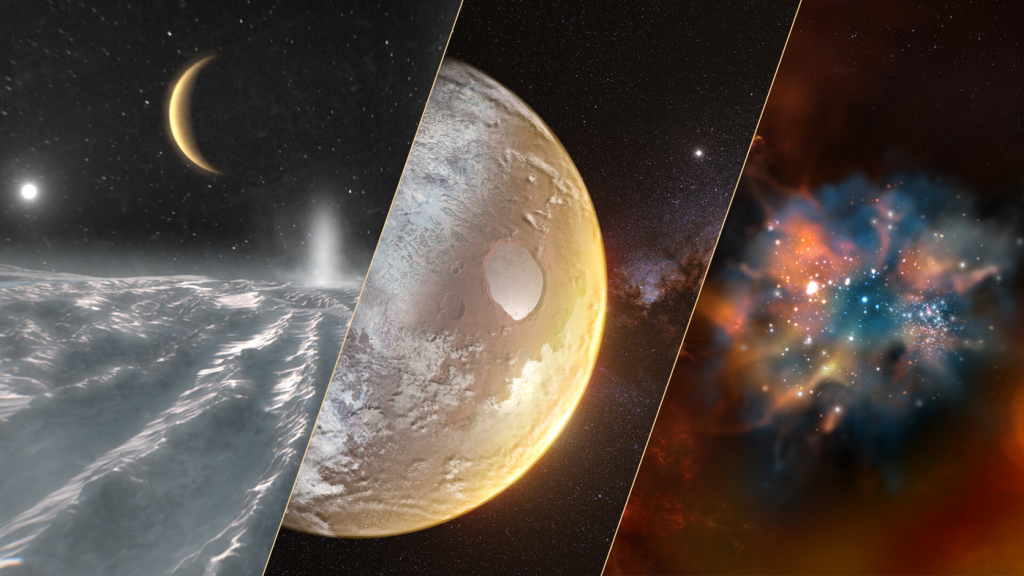The European Space Agency (ESA) this week selected the topics for future missions for the Voyager 2050 program. The science missions from 2035 to 2050 will focus on the moons of the solar system’s giant planets, temperate exoplanets, and early-stage studies. Universe. The selection was made based on ideas received in 2019, and represents a moment of great importance to the ESA Science Programme.
ESA opened a call in 2019 to receive ideas for the program and received nearly 100 proposals, which were broken down into themes. Then teams of scientists from various fields of space science carried out a preliminary analysis of the ideas and took the results to a higher scientific committee, which indicated themes for the next three upper-tier missions, and identified ideas for middle-class missions, at a fraction of the cost, and recommended areas for technology development.
Our Cosmic Vision missions program has a clear plan through the mid 2030s, so we must now plan for the technology we will need for missions decades from now. Enters # Journey 2050!
cosmic vision backgroundhttps://t.co/br0T6AMByu pic.twitter.com/KglyLRepe5
– ESA Science (esascience) June 11, 2021
Günther Hasinger, Director of Science at ESA, commented that the selection of subjects represented a pivotal moment for the space agency’s science program and for future generations of space scientists and engineers: “Now that the cosmic vision has crystallized, with a plan of course for missions by the mid-2030s, we need to begin to Planning for the science and technology we will need for the missions we want to launch.” “That’s why we’re identifying the science topics for Voyage 2050 today.”
The Voyage 2050 Commission raised issues related to all areas of space science, demonstrating the scientific potential that could be achieved within the cost limits of middle-class missions. Thus, advance and long-term planning is necessary to ensure the success of space science plans – especially in the case of large missions, which require technological development over several years. Therefore, it is important to determine the necessary technology in advance.
Check out the three priorities identified for future high-level missions:
Giant planets moons
To understand the origin of life, it is necessary to analyze the possibility of habitation of planets in the solar system. So, taking advantage of the legacy of the Cassini-Huygens mission, which was launched towards Saturn, as well as the expected return of the future explored icy moons of Jupiter, a mission dedicated to the outer solar system and equipped with advanced instruments, it can study the communication between the planets’ moons, the oceans in the interior, and nearby environments. From the surface—and who knows, look for potential biometric fingerprints. This mission profile could include a drone or landing craft.
From the temperate exoplanets to the Milky Way

Our galaxy is made up of hundreds of millions of stars and planets, as well as dark and interstellar matter. However, our understanding of this ecosystem is limited, and understanding the formation history of the Milky Way and its “hidden” regions is essential for astronomers to understand galaxies in general. In parallel, the characterization of temperate exoplanets by the spectrum of thermal emission, coming from their atmosphere, can contribute to studies of the surface conditions for the emergence of life.
New studies of the primordial universe

We still don’t know exactly how the universe began or how the first cosmic structures and black holes arose and evolved, but these fundamental questions can be answered through missions with new probes; The idea is that they detect gravitational waves with high accuracy either through a new spectral window, or by high-resolution spectroscopy of the cosmic background radiation left over from the Big Bang. This topic addresses the science produced by the Planckand mission and the expected return of the LISA mission, and may further advance the hardware to allow for major discoveries.
Source: who – which
Did you like this article?
Subscribe to your Canaltech email to receive daily updates with the latest news from the world of technology.

“Hardcore beer fanatic. Falls down a lot. Professional coffee fan. Music ninja.”






More Stories
The law allows children and adolescents to visit parents in the hospital.
Scientists pave the way for the emergence of a new element in the periodic table | World and Science
Can dengue cause hair loss? Expert explains how the disease affects hair